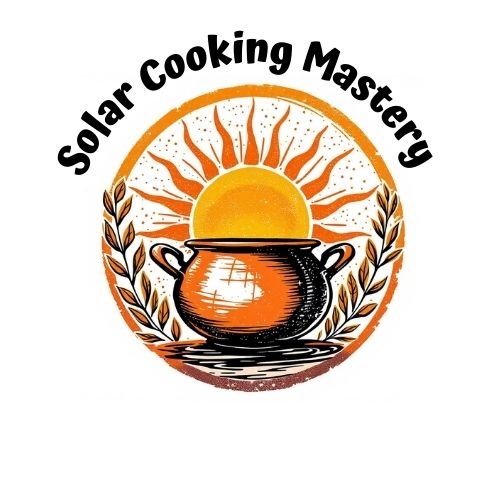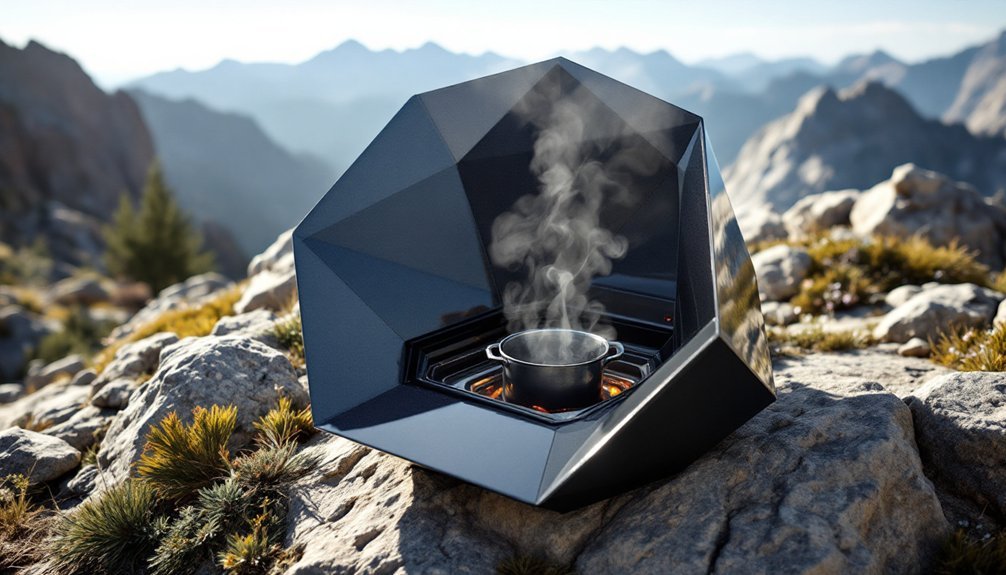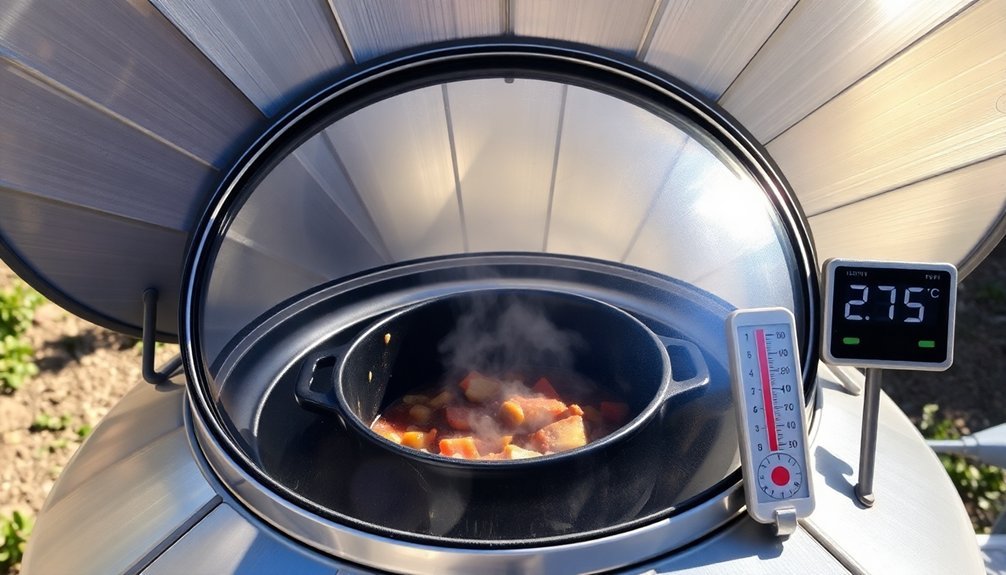If you're planning a backpacking adventure, you'll want to contemplate adding a lightweight solar oven to your gear list. These innovative devices can transform your outdoor cooking experience while keeping your pack weight manageable. From ultra-compact models weighing just 2 pounds to versatile options that reach temperatures of 550°F, today's solar ovens offer impressive capabilities without the need for fuel. Let's explore the top seven options that'll make your trail meals more sustainable and enjoyable.
Solar Cooker for Outdoor and Home Cooking
For adventurers who want to cook delicious meals without lugging heavy equipment, the All Season Solar Cooker offers an ideal solution. At just 4 pounds, this portable stove lets you boil, bake, and steam food using only sunlight.
You'll appreciate the durable food-grade polypropylene construction that withstands repeated folding and outdoor elements. The cooker's innovative design maximizes sunlight gathering for faster cooking times, while its spacious capacity handles larger portions. When you're done cooking, it folds down for easy storage and transport. Whether you're camping, backpacking, or cooking at home, you can prepare meals hands-free while enjoying other activities.
Best For: Outdoor enthusiasts, campers, and eco-conscious home cooks who want a portable, hands-free cooking solution that harnesses solar power.
Pros:
- Lightweight and portable at only 4 pounds with foldable design
- Versatile cooking methods including boiling, baking, and steaming
- Durable food-grade polypropylene construction that resists heat and corrosion
Cons:
- Dependent on sunlight availability for operation
- Cooking times may be longer than traditional methods
- May require learning curve to master solar cooking techniques
Solar Oven Portable Cooker (4.5L Capacity)
Serious backpackers who need a reliable cooking solution for small groups will appreciate the MrMapMax Solar Oven's blend of portability and power. At 13.85 pounds, this 4.5L cooker reaches temperatures up to 550°F and can prepare meals in just 20 minutes.
You'll find its versatility impressive, as it works even in cloudy conditions by capturing UV light. The vacuum tube chamber guarantees excellent heat retention, while the zipper design makes setup quick. The handbag-style carrying strap enhances portability on trails. For backpackers cooking for 2-3 people, you won't need to worry about fuel – just harness the sun's energy for consistently tender, evenly cooked meals.
Best For: Eco-conscious backpackers and campers cooking for small groups who want a fuel-free cooking solution and don't mind the extra weight for the benefit of reliable solar cooking.
Pros:
- Reaches impressive temperatures (up to 550°F) and cooks quickly (20 minutes) in full sunlight
- Works even in cloudy conditions thanks to UV light capture capability
- Convenient portability features with handbag design and zipper setup
Cons:
- Relatively heavy at 13.85 pounds, which may be too much for ultralight backpackers
- Capacity limited to 3 lbs of food for optimal cooking performance
- Requires direct sunlight for best results, making meal timing dependent on weather conditions
Premium Solar Oven, Portable Outdoor Solar Cooker & Camping Oven
Backpackers seeking a reliable solar cooking solution will appreciate this premium portable oven, which reaches temperatures up to 212°F while maintaining a lightweight design. You'll find it accommodates a 5-quart Dutch oven and includes support rods for stability.
The reinforced foam construction and reflective metal deliver consistent cooking temperatures between 190-208°F. While it takes 1-6 hours to cook meals fully, you can reheat canned goods in just 30-40 minutes. For best results, elevate your cookware 1-2 inches, use black pots with glass lids, and reposition the oven to track the sun's movement. Keep in mind you'll need to manage the pliable plastic cover and secure it against wind.
Best For: Eco-conscious backpackers and outdoor enthusiasts who want a portable, fuel-free cooking solution and don't mind longer cooking times.
Pros:
- Lightweight and portable design makes it ideal for camping and outdoor activities
- Reaches cooking temperatures up to 212°F without requiring fuel or electricity
- Versatile enough to handle various cooking methods from reheating to baking
Cons:
- Long cooking times ranging from 1-6 hours for full meals
- Requires frequent repositioning to follow the sun for optimal performance
- Plastic cover can become unstable in windy conditions and may sag onto cookware
All Season Solar Cooker (17) Camper
The All Season Solar Cooker (17) Camper stands out among portable solar ovens with its impressive 1.5-kilowatt output and ability to cook year-round, even in winter conditions.
At just 4 pounds, you'll find this sunny yellow cooker surprisingly portable, folding down to an inch thick for easy packing. The articulating collector panels capture ideal sunlight, heating up to 250 degrees for effective baking and cooking. You'll appreciate its durable polypropylene construction that won't tear or get waterlogged.
While it offers the largest cooking area of any solar cooker, some users find the larger size makes adjustments tricky. For backpackers, the smaller version might be more manageable.
Best For: Outdoor enthusiasts and eco-conscious campers who want to prepare large meals using solar power and need a versatile cooking solution that works year-round, even in winter conditions.
Pros:
- High power output (1.5 kilowatts) and temperatures up to 250 degrees make it effective for genuine cooking and baking
- Extremely lightweight at 4 pounds and folds down to just one inch thick for easy transport
- Durable, waterproof construction with large cooking capacity that can accommodate a turkey roaster
Cons:
- Larger size can make adjustments and positioning more challenging
- Some users report unclear assembly instructions
- Price point is considered high compared to similar solar cooking alternatives
GOSUN Solar Oven PRO Portable Camp Stove
Modern adventurers seeking a lightweight cooking solution will find the GOSUN Solar Oven PRO Portable Camp Stove compelling, thanks to its 2-pound design and ability to reach temperatures up to 550°F.
You'll appreciate its handbag-like portability and versatile cooking functions – from baking to roasting. The oven cooks meals in about 20 minutes while retaining nutrients and moisture. With dimensions of 17L x 6W x 9H inches, it's perfect for solo backpackers or couples.
While the cooking capacity is limited to single servings, you'll enjoy propane-free cooking wherever there's sunlight. The convenient zipper design and silicone trays make cleaning and storage hassle-free.
Best For: Solo campers, hikers, and outdoor enthusiasts who prioritize lightweight gear and don't mind cooking small portions using solar power.
Pros:
- Extremely portable and lightweight at just 2 pounds
- Reaches high temperatures (up to 550°F) without fuel or electricity
- Quick cooking time of around 20 minutes with moisture retention
Cons:
- Limited cooking capacity – only suitable for one adult portion
- Requires direct sunlight to function effectively
- Some users report issues with lid sealing and cooking greasy foods
GOSUN Sport Solar Oven for Camping & Hiking
Among lightweight solar ovens, the GoSun Sport stands out as a powerful and efficient cooking solution. You'll appreciate its ability to reach 550°F in full sunlight, cooking meals in just 20 minutes while converting 80% of sunlight into usable heat.
The Sport's innovative design features foldable parabolic reflectors and a borosilicate glass cooking chamber that keeps the exterior cool. At 8 pounds, it's portable enough for outdoor adventures, and you won't need fuel or fire. Whether you're cooking hot dogs, chicken, or brownies, the 360° heating guarantees even results. Its durable construction and 2-year warranty make it a reliable choice for campers, hikers, and emergency preparedness.
Best For: Outdoor enthusiasts, campers, and emergency preppers seeking a portable, fuel-free cooking solution that's both eco-friendly and efficient.
Pros:
- Reaches high temperatures quickly (up to 550°F) and cooks meals in as little as 20 minutes
- Safe and easy to use with no fire hazard and cool-touch exterior
- Durable construction with 2-year warranty and impressive 80% solar energy conversion rate
Cons:
- Requires decent sunlight to function effectively
- Limited cooking capacity due to tube design
- Relatively high price point compared to traditional portable stoves
GOSUN Go Portable Solar Camping Stove
Serious ultralight backpackers seeking a fuel-free cooking solution will find the GOSUN Go Portable Solar Camping Stove an intriguing option at just 2 pounds. The stove reaches temperatures up to 550°F and can cook meals in as little as 20 minutes using only sunlight.
You'll appreciate its compact design that fits easily in your pack, though the 0.9L capacity limits cooking to solo meals. The evacuated glass tube and parabolic reflectors effectively capture UV light, but you'll need to master positioning for peak performance. While some users struggle with reaching boiling temperatures, the stove excels at cooking simple foods like eggs, chicken, and potatoes.
Best For: Solo ultralight backpackers and outdoor enthusiasts who prioritize fuel-free cooking and don't mind the learning curve of solar cooking.
Pros:
- Completely fuel-free cooking solution at an ultralight weight of 2 pounds
- Can reach impressive temperatures up to 550°F using only solar power
- Compact and portable design makes it easy to pack and carry
Cons:
- Small 0.9L capacity limits cooking to individual portions
- Requires direct sunlight and proper positioning to function effectively
- Higher price point compared to traditional camping stoves
Factors to Consider When Choosing a Lightweight Solar Oven for Backpacking
When selecting a solar oven for your backpacking adventures, you'll need to carefully evaluate several critical features, including the unit's weight, packed dimensions, and maximum temperature capabilities. You'll want to contemplate how long you're willing to wait for meals to cook and how the oven performs in various weather conditions, as some models work better than others in partial sun or windy conditions. The durability of materials matters greatly, as your solar oven must withstand the rigors of trail life while maintaining its effectiveness over multiple trips.
Weight and Packed Size
Selecting the right solar oven for backpacking requires careful attention to weight and packed size, as these factors directly impact your hiking experience. You'll want to choose an oven that weighs less than 5 pounds to prevent unnecessary strain during long treks.
Look for models that can collapse to less than an inch in thickness when packed, making them easy to slip into your backpack without taking up valuable space. The best portable solar ovens combine lightweight materials with sturdy construction, ensuring they'll hold up to outdoor use while remaining easy to carry. When evaluating options, you'll also need to take into account the cooking capacity relative to the overall size. Choose a design that's simple to assemble and disassemble, as this will make your trail cooking experience more enjoyable.
Maximum Temperature Range
Understanding a solar oven's maximum temperature range is essential for planning your backcountry meals effectively. You'll find that quality lightweight models can reach impressive temperatures up to 550°F in prime sunlight, giving you flexibility to prepare diverse meals on the trail.
Most solar ovens maintain cooking temperatures between 200°F and 250°F, which you'll find suitable for baking, boiling, and steaming your food. The performance you'll get depends largely on the oven's design and materials – better reflectors and insulation mean higher temperatures and improved heat retention.
Don't let cloudy days discourage you, as many models can still capture ultraviolet light in less-than-ideal conditions. When choosing your solar oven, match the temperature range to your cooking style and meal preferences.
Cooking Time Requirements
Just as temperature range affects your cooking options, solar oven cooking times determine how you'll plan your backcountry meals. Under ideal sunlight conditions, you can prepare meals in as little as 20 minutes, but you'll need to take into account weather variables that can extend cooking durations.
While these ovens can reach impressive temperatures up to 550°F, cloud cover and partial shade will impact your cooking schedule. You'll want to reflect on your typical hiking routine when selecting an oven – if you prefer cooking during brief trail breaks, look for models that heat quickly and retain temperature well. Match the oven's capacity to your group size, as larger meals require more time. Even in less-than-ideal conditions, you can still cook effectively by adjusting your timing and meal planning accordingly.
Weather Performance Capabilities
When evaluating solar ovens for backpacking, weather performance should top your priority list. You'll find that today's lightweight models can perform effectively even in less-than-ideal conditions, including cloudy days and snowy weather, thanks to their ability to harness ultraviolet light.
Look for ovens with superior insulation that maintain cooking temperatures despite weather fluctuations. The best models can reach up to 550°F in full sun and still function efficiently in overcast conditions. You'll want to take into account units specifically designed for low-sun environments, as they're engineered to maximize solar capture. With excellent sunlight, you can cook meals in as little as 20 minutes, making these ovens practical for various weather scenarios. Pay attention to construction materials and design features that enhance performance across different climate conditions.
Material Durability Quality
Despite being lightweight, your solar oven's durability plays an important role in its long-term performance and reliability on the trail. When evaluating material quality, look for stainless steel components, which offer superior corrosion resistance compared to plastic alternatives. If you're considering a model with plastic components, choose one that uses food-grade virgin polypropylene flute panels, as they provide excellent heat resistance and durability.
Your solar oven should withstand repeated folding and bending without showing signs of wear, making it ideal for frequent backpacking use. Pay attention to the insulation materials, such as reinforced foam and high-quality reflective surfaces, as they'll maintain both heat efficiency and structural integrity. While lightweight design is vital for portability, don't compromise on material strength – it's crucial for your oven's longevity in outdoor conditions.
Food Capacity Limits
Understanding your solar oven's food capacity limits will make or break your backpacking meal plans. You'll find most lightweight models offer capacities between 0.9L and 4.5L, which you'll need to match carefully with your group size. For solo trips, a smaller capacity works fine, but you'll want more space when cooking for 2-3 people.
Keep in mind that many solar ovens have a maximum weight limit of around 3 lbs of food for peak cooking performance. While larger capacities let you cook complete meals or multiple items simultaneously, they'll add extra weight to your pack. When selecting your oven, consider the trade-off between cooking capacity and portability – there's no point having a large capacity if it's too heavy to carry comfortably on your trek.
Setup and Storage
Beyond food capacity considerations, setup and storage requirements can make or break your solar oven choice. You'll want to look for models that fold down to less than an inch thick, making them easy to slip into your backpack without taking up precious space.
The best portable solar ovens feature quick-deploy designs that you can set up in seconds when you're ready to cook. Don't overlook the importance of carrying handles or straps – they'll make a significant difference during long hikes. Since you'll be folding and unfolding your oven frequently, choose one made with durable materials that can handle repeated use. While weights vary from 2 to 13.85 pounds, opt for lighter models if you're planning extended trips where every ounce counts.
Sun Tracking Needs
When selecting a solar oven for backpacking, efficient sun tracking capabilities can make the difference between a hot meal and lukewarm disappointment. You'll want to look for models with adjustable reflective panels that you can easily reposition throughout the day to maximize sunlight capture and heat absorption.
Choose an oven that maintains consistent heat even as the sun's position changes. While some designs offer sophisticated tracking features, they might require more setup time and effort to align properly. Consider whether you're willing to trade quick meal prep for enhanced solar efficiency. The best options combine lightweight, durable materials with user-friendly adjustment mechanisms, allowing you to effectively track the sun without adding unnecessary complexity to your outdoor cooking experience.
Frequently Asked Questions
Can Solar Ovens Work Effectively on Cloudy or Overcast Days?
You'll find solar ovens work less effectively on cloudy days, as they need direct sunlight. While they can still function with some cloud cover, you'll experience longer cooking times and lower maximum temperatures.
How Long Does It Take to Sterilize Water in a Solar Oven?
You'll need about 20-30 minutes to sterilize water in a solar oven once it reaches 150°F (65°C). Make sure you maintain this temperature for the full duration to kill harmful bacteria and pathogens.
What Is the Average Lifespan of a Portable Solar Oven?
You'll typically get 3-5 years from a portable solar oven with regular use, but if you're careful with maintenance and storage, it can last up to 10 years. Proper cleaning and protection from elements matter.
Are Solar Ovens Safe to Leave Unattended While Cooking?
You shouldn't leave solar ovens unattended while cooking. Though they're generally safe, unexpected weather changes or animals could disturb your setup. It's best to monitor your food and maintain proper cooking temperatures.
Can Solar Ovens Be Used at High Altitudes During Mountain Expeditions?
You'll find solar ovens work effectively at high altitudes since there's less atmospheric interference. They're actually more efficient up there, but you'll need clear skies and to account for longer cooking times.





Leave a Reply